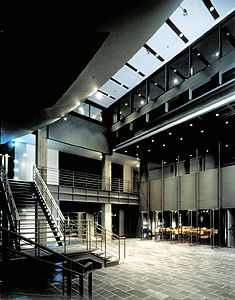The Montréal architectural firm Saucier + Perrotte architectes was established in 1988 by Gilles Saucier (born 22 December 1958 in Ste-Françoise, QC) and André Perrotte (born 6 June 1959 in Ste-Foy, QC).
Education and Early Career
Both Gilles Saucier and André Perrotte graduated from the School of Architecture at Université Laval in 1982. The firm quickly placed itself at the forefront of a new generation of Québec architects, working with bold concepts, elegant planning, a keen attention to geography and climate, and precise construction details. They compose views, landscaping and materials to make sophisticated connections between inside rooms and outside surroundings, and have an established reputation for dramatically transforming existing structures.
Saucier + Perrotte first made their mark with a number of competition entries and formative projects. A series of theatre projects in Montréal, including the Théâtre du Rideau Vert (1990), the Théâtre d'Aujourd'hui (1990–91) and the headquarters of the Carbone 14 theatre company (1993–95), demonstrated the firm's ability to transform existing structures into dynamic and contemporary works of architecture. This thematic direction was underscored by the changes the practice undertook to the Cinémathèque québécoise (1994–97). Uniting two existing buildings with a dramatic and engaging link that houses a café, cinema and gallery, the design revitalized a unique institution by bringing together cinema and architecture; it used mullionless glass walls, exposed concrete and a signature muted colour palette of greys and blacks.
Mature Work
The firm's commercial design projects for fashion retailer Philippe Dubuc (2006), Scandinave Les Bains Vieux-Montréal (2007–09) and its own office in a manufacturing building in Montréal (2006–07) showcase a similar ingenuity in transforming old buildings into sleek, daring interiors. Another significant work is the Université de Montréal's Faculté d'aménagement, built to house the School of Architecture, which features a bold addition to a former Catholic convent building.
The work of Saucier + Perrotte architectes is characterized by a re-evaluation of the canonical elements and forms of modern architecture as well as a celebration of the theatricality of human movement through and around buildings. Their sensitivity to problems inherent in early 20th-century modern architecture has also produced a strong commitment to the operations of the city. This approach to urban design is evident, for instance, in Saucier + Perrotte's winning entry for a housing competition held in 1993 for the Faubourg-Québec area adjacent to Old Montréal.
Saucier + Perrotte's portfolio ranges from small projects, such as a widely publicized private home and guest house in the Laurentian Mountains (2003–07), to major institutional buildings such as the Communication, Culture and Technology Building for the University of Toronto at Mississauga (2001–04) and the Perimeter Institute for Theoretical Physics in Waterloo, Ontario (2000–04). Some of their unbuilt designs have received critical acclaim, in particular their proposal for the Canadian Museum for Human Rights in Winnipeg (2003). They also have significant exhibition experience, including the permanent First Nations Garden Pavilion, built in Montréal in 2001, and the design of 1973: Sorry, Out of Gas, which was installed at the Canadian Centre for Architecture in 2007. In 2004, the firm represented Canada at the Architecture Biennale of Venice with an innovative exhibition of laser-cut, painted steel models.
Honours and Awards
Saucier + Perrotte architectes have received wide recognition in Québec, across Canada and internationally, winning numerous awards for their work. Among these are awards of excellence from the Ordre des architectes du Québec for the Théâtre du Rideau Vert (1991) and the Cinémathèque Québécoise (1998), and from Canadian Architect magazine for the Théâtre d'Aujourd'hui (1990), the McGill University Faculty of Music (1994) and the Université de Montréal's Faculté d'aménagement (1995). The firm received a RAIC 1997 Governor General's Award of Merit for their work on Usine C, Carbone 14’s centre for research and multidisciplinary creation. Saucier + Perrotte also received the Royal Architectural Institute of Canada's Architectural Firm Award in 2009. The prize celebrates their place at the forefront of an influential generation of Québec architects. They have been awarded seven prestigious Governor General's Medals in Architecture.

 Share on Facebook
Share on Facebook Share on X
Share on X Share by Email
Share by Email Share on Google Classroom
Share on Google Classroom







